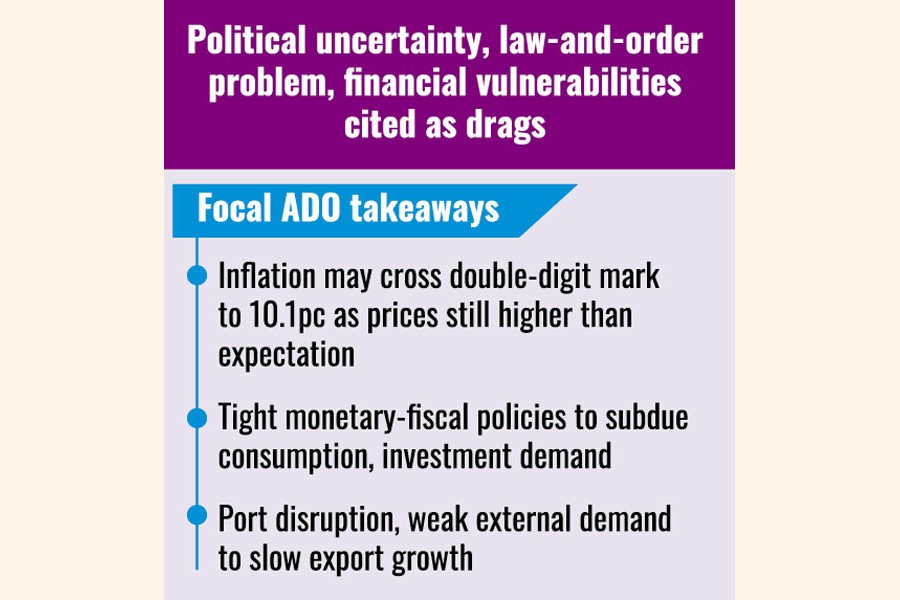
Asian Development Bank's revised outlook of Bangladesh's economy projects a dip in the GDP growth by 1.50-percentage points to 5.1 per cent in the current fiscal for a slew of downside risks.
The wellspring of risks mostly comprises continuing political uncertainty, an insecure law-and-order situation, and financial-sector vulnerabilities, the banker to the Asian nations says in its latest assessment report that, incidentally, comes after the Augus-5th changeover in Bangladesh.
It also forecasts that country's inflation this year may cross double-digit mark to 10.1 per cent as the prices of essentials are still higher than expectation.
The Manila-based banker to Asian nations has pared down Bangladesh's GDP growth forecast to 5.1 per cent in the current fiscal year (FY) 2024-25 from 6.6 per cent it had projected in its Asian Development Outlook (ADO) report this past April.
"The forecast is highly uncertain because the economic impact from political unrest in July and August and from recent floods has yet to be adequately assessed," says the ADB in its Asian Development Outlook (ADO) September 2024, rolled out Wednesday globally.
"Economic activity was already slowing prior to July as industry had weakened. Manufacturing output, notably readymade garments, will lag further following disruption at factories and at ports, backlogging shipments," it says enumerating the drawbacks.
"Service output was also hindered by the political unrest and flooding and will be further affected if nonperforming loans worsen and other banking vulnerabilities persist.
"Tight monetary and fiscal policies will continue to subdue consumption and investment demand. Port disruption and weak external demand will slow export growth," the report adds.
Earlier in April this year, global-lender World Bank also downsized Bangladesh's GDP growth by 0.1 percentage point to 5.7 per cent for the current fiscal.
Elevated inflation, power shortages, import restrictions, and financial-sector vulnerabilities weighed on the economic outlook, the lender showed as the reasons behind the lower-growth forecast.
The ADB in its ADO September 2024 report says the lower GDP growth is projected as reduced export demand and domestic energy shortages took their toll on industrial growth, and as adverse weather constrained agriculture.
"The forecast is highly uncertain as significant downside risks muddy the macroeconomic outlook. These risks arise mostly from continuing political uncertainty, an insecure law-and-order situation, and financial-sector vulnerabilities."
About the higher inflation, the ADB says Bangladesh's inflation is projected to increase to 10.1 per cent in FY2025, higher than the April 2024 forecast.
"Elevated food and non-food prices in the first half of the fiscal year reflect supply-side disruption and higher import costs due to currency depreciation, pushing up inflation forecasts."
However, inflationary pressures are expected to moderate in the second half of the fiscal year as tight monetary and fiscal policies lower domestic demand.
The central bank's monetary-policy statement indicates tight monetary policy continuing in FY2025.
About budget deficit, the ADB says the FY2025 budget plans a deficit equal to 4.6 per cent of GDP, narrower than the 4.7-percent target in the revised FY2024 budget.
Fiscal revenue is slated to grow to 9.6 per cent of GDP while expenditure is contained at 14.2 per cent of GDP. Current expenditure is projected to increase by 8.0 per cent and capital expenditure by 8.2 per cent.
About 63.0 per cent of the fiscal deficit will be financed domestically, 85.5 per cent from banks and 14.5 per cent from other sources, mostly the sale of national savings certificates, it notes.
However, given the state of public finance following the political unrest, these revenue and expenditure targets may be "somewhat ambitious", the ADB states in the ADO.
It says: "The interim government expects to revise its budget estimates according to realistic projections for revenue mobilization and expenditure consolidation. The revised budget will include a number of measures to expand the tax base and will recognize that higher interest payments on outstanding public debt accumulated in recent years will constrain public capital spending."
The bank has projected a weaker external position in FY202 as the current-account deficit is forecast to equal to 1.3 per cent of GDP, little changed from FY2024.
"Imports will likely grow at a slightly faster pace than in FY2024 while export growth continues to slow, but high remittance inflows should narrow the current account deficit marginally in FY2025."
Tighter policies and low foreign-exchange reserves will limit import growth, and supply disruption in the first quarter will constrain export growth.
"Growth in workers' remittances will be aided by a weakened currency and improved ease of transfer through formal banking channels. Pressure on foreign-exchange reserves is likely to remain in the near term."
However, continued alignment of the exchange rate through further widening of the currency band, monetary-policy tightening, import-compression measures, robust remittance inflows, and foreign investment, should lead to a buildup of reserves over the medium term, the ADB forecasts.
On the downside risks, it says the risks arise from evolving political uncertainties, the law-and-order situation, data gaps and integrity, the challenge to achieving fiscal objectives, finance- sector vulnerabilities, and weak external demand.
"In the face of these risks, the interim government has formed a committee to prepare a white paper that transparently lays out the state of the economy and recommends reforms for macroeconomic stability, achieving the Sustainable
Development Goals, and mitigating challenges that will arise after Bangladesh graduates from the least-developed country category in 2026."
The government also plans to form three taskforces to lay out a roadmap for banking-sector reform.
About the South Asian region, the ADB in its report says the subregional economic growth forecast is unchanged from ADO April 2024 for 2024 and slightly lower for 2025.
The growth outlook for most countries in the subregion is either unchanged or improved since April. The exceptions are Bangladesh and the Maldives, where lower growth is forecast in both 2024 and 2025.
Most inflation forecasts are little changed. Risks to the outlook are balanced in India but on the downside in other South Asian economies.
kabirhumayan10@gmail.com
© 2025 - All Rights with The Financial Express
